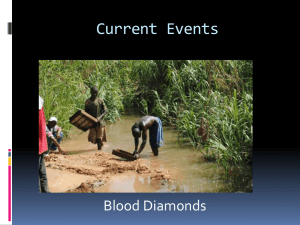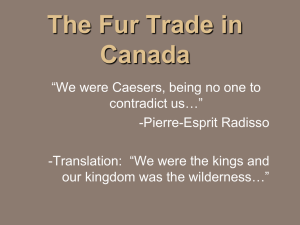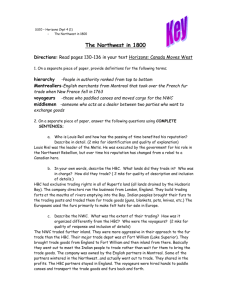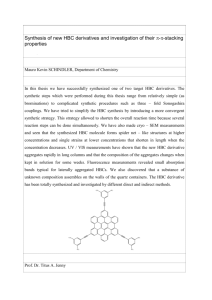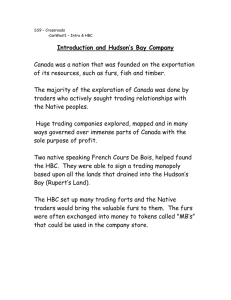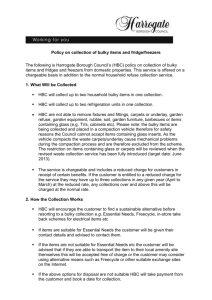HBCNWCSelkirkSettlementFurTrade
advertisement
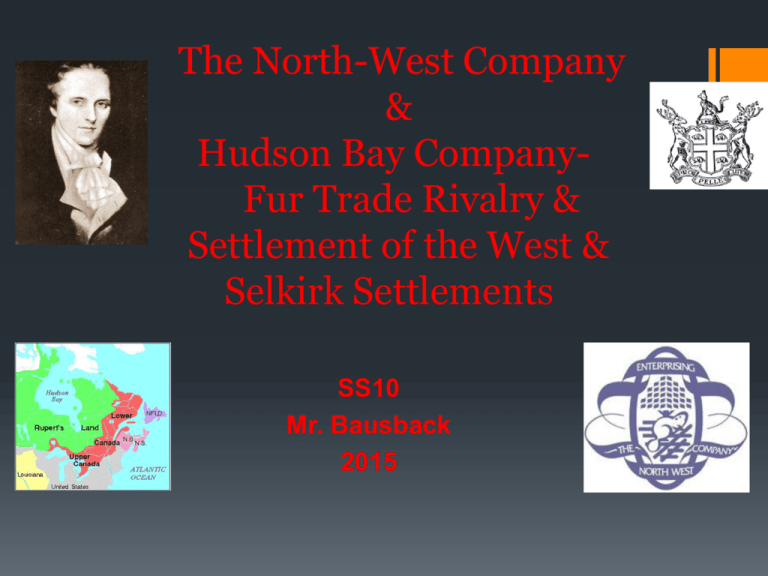
The North-West Company & Hudson Bay CompanyFur Trade Rivalry & Settlement of the West & Selkirk Settlements SS10 Mr. Bausback 2015 I. Historic Map of CanadaLabel the Following: 1. Physical Features- Rivers: • • • • • • • Fraser River Columbia River Peace River Athabasca River Saskatchewan River (N&S) Assiniboine River Red River (MB) • Albany River • Ohio River • Mississippi River • Missouri River • St. Lawrence River • Ottawa River • Saugenay River II. Historic Map of Canada • • • • • • • • 2. Physical Features- Land & Water Features: Prairies • Lake Manitoba Interior Plains • Lake of the Canadian Shield Woods Rocky Mountains • Lake Athabasca Great Lakes (5) • Great Slave Lake Hudson Bay • Pacific Ocean James Bay • Atlantic Ocean Lake Winnipeg • Gulf of St. Lawrence III. Historic Map of Canada 3. Settlements & Trading Posts: • Fort William (NWC) • • • • • • • Rupert's Land Selkirk Settlement York Factory (HBC) Fort Churchill (HBC) Prince of Wales's Fort (HBC) Moose Factory (HBC) Fort Carlton (HBC) • Fort Douglas (NWC) • Fort Gary (HBC) • Edmonton House (HBC) • Fort George (HBC) • Fort Langley (HBC) • Fort Victoria (HBC) IV. Historic Map of Canada 5. More Settlements & Trading Posts: • • • • • • Fort St. John (NWC) Fort St. James (NWC) Rocky Mountain House (NWC) Chesterfield House (HBC) Fort McMurray (NWC) Fort Gibraltar (NWC) V. Historic Map of CanadaLabel the trade routes of these explorers Explorers David Thompson Alexander Mackenzie Simon Fraser Raddisson, Pierre Esprit James Cook Robert La Salle George Vancouver Henry Hudson Martin Frobisher Pierre de la Verendrye Part I: Compare and contrast of HBC and North-West Company The North West Company North West Company (NWC) was a fur-trading enterprise based in Montreal active in the Canadian West from the 1770s until 1821. The company was run mainly by Scots immigrants who came to Montreal after 1760. They relied for their workforce on French-Canadian voyageurs who had been trading in the fur country for years. Nor'Westers, as the company men were called, were among the most daring adventurers and skilled traders in the Northwest. The era of the North West Company was one of the most colourful in Canadian history. The North West Company • • • • • The company began as a partnership of fur-trade merchants in the 1770s. These traders were finding it expensive to compete against each other so they decided to pool their resources in 1783-84. Some of the leading partners were Simon McTavish, Joseph and Thomas Frobisher, James McGill, and Isaac Todd. Simon McTavish was the leading partner until his death in 1804, when he was followed by William McGillivray. Because of the great distance between the western fur posts and Montreal, the NWC worked out a unique transportation system. Each summer canoes from the St Lawrence River carried supplies to the head of Lake Superior where they met the canoes laden with furs from the interior. Originally this rendezvous took place at Grand Portage. Later, the site moved to Fort William. After exchanging their goods, and having a grand celebration, the two sets of canoes returned back in the direction they had come for another season. The North West Company • The NWC soon emerged as the dominant fur-trade enterprise in Montreal and the trade became a rivalry between the Nor'Westers and the Hudson's Bay Company (HBC), based to the north in Hudson Bay. • This rivalry lasted many years and was very bitter. The two companies built posts next to each other and fought for furs and food supplies. • Indians were bribed to bring in their trade and several people were killed during the conflict. • The need to find new supplies of furs led the traders deeper into the north and west. • The Nor'Westers were noted especially for their skills as explorers. Men like Alexander Mackenzie, Simon Fraser, and David Thompson carried the fur trade all the way across the Rocky Mountains to the Pacific Ocean The Hudson's Bay Company • Although the HBC enjoyed the advantage of being closer to the source of furs in the North West, the French still controlled most of the trade, merchants hired hundreds of voyageurs, who were paid to gather the furs and carry them back to Montreal. Some of these voyageurs wintered in the North West, and received more pay. • They bought their furs to Grand Portage, on Lake Superior, a second group of voyageurs, in larger canoes, carried the furs from Grand Portage to Montreal. • Between 1715 and the fall of New France in 1763, the fur trade expanded greatly. • Several fur traders, such as the La Vérendrye family, were granted rights to trade in the North West. • In return, they explored, kept good relations with the native people, and build posts to keep the English out. • By 1756, the traders had reached as west as the foothills of the Rocky Mountains and as far south as the mouth of the Mississippi. • Throughout this period, competition continued between the Canadien traders and the HBC. • The HBC traders did not have the French skills with canoes. They waited in their posts on the Bay for the native traders to come to them. This policy was known as “Stay by the Bay”. Competition Between the NWC and HBC • The violent competition between the NWC and the HBC came to a head with the creation of the Red River Colony in 1812. • The Nor'Westers saw this colony as a plot by the HBC to ruin their trade, the local Metis sided with the NWC and together they decided to drive the colony from the country. • All this bad feeling resulted in the violent meeting at Seven Oaks in 1816, where 21 colonists died. • Finally the two companies called a truce, The Nor'Westers were divided among themselves, and the British government wanted peace in the fur country. • In 1821 the NWC was absorbed into the HBC, many of the Nor'Westers went to work for their old rival and the HBC gained control of the fur trade in the west. • In 1772 two of these coureurs, Pierre Radisson and Groseilliers, went over to the English, they opened a new route via Hudson Bay which presented a new challenge to the St Lawrence. • In 1670 the Hudson's Bay Company (HBC) began to build posts on Hudson Bay. Competition Between the NWC and HBC • The NWC and HBC carried on a fierce battle for furs in the North West, the two companies leap-frogged past one another's posts along the Saskatchewan River. • Despite the disadvantage of distance, the NWC dominated the trade, each year the fur brigades would leave Fort Chipewyan, bound for Grand Portage (later replaced by Fort William). • Montreal merchants, such as Simon McTavish and James McGill, amassed large fortunes. • NWC explorers Alexander Mackenzie, Simon Fraser, and David Thompson opened up vast new areas in the Northwest. • The competition broke into open violence in 1816 when HBC settlers at Red River clashed with the local Metis, who were allied with the NWC, the colony's governor and 20 others were killed. • In 1821 the two companies joined under the HBC name and the Montreal-based trade came to an end. • The fur trade played a very important role in the creation of Canada, it led to exploration of much of the country and it built a strong tie between the North West and the St Lawrence, based on the waterways. • It encouraged relatively peaceful relations with the native people. It gave rise to intermarriage between traders and native women, which blended native and European cultures. Part II: Brief History of the Selkirk Settlement: Who Were The First Explorers? The French were the first European explorers to come to the Red River. They were led by Pierre La Verendrye. The trail that they explored and left behind is called the La Verendrye trail. Who Was Lord Selkirk? Lord Selkirk was a Scottish nobleman. His full name was Thomas Douglas, the Fifth Earl of Selkirk. Lord The Selkirk Settlers In the early 1800’s, Scottish peasants were in trouble. People started to raise sheep but to do so they needed large amounts of land The peasants that used to live on the fields were cleared off and didn’t have a home anymore. Lord Selkirk saw that his people were being cleared out of their homes and wanted to help them. Where Did They Go? There was no land for the peasants to live on in Scotland so Lord Selkirk had to send them somewhere else. Lord Selkirk decided to send them to North America. The Hudson’s Bay Company gave Lord Selkirk a lot of land near the Red River. The first group of the Selkirk settlers arrived in 1812. Arguments The town they built grew quickly. The Métis people were still living in the same area between Selkirk and Winnipeg when the Selkirk settlers arrived. There were many disputes between them because the Métis didn’t like the Selkirk settlers living on their land. A big fight even happened called the Seven Oaks Massacre. The fighting stopped when Lord Selkirk sent some soldiers from Scotland. Moving After a while, the children of the Selkirk settlers wanted to move. They wanted to move away because the land they lived on continuously flooded. They moved to the Selkirk area in St. Clements because it didn’t flood here. East Selkirk Roundhouse/ Immigration Shed The Selkirk settlers built the East Selkirk Roundhouse/Immigration Shed. It was originally supposed to fix train engines but never did. Instead people moving here from other countries used it as a first house. Arriving in St. Clements The Selkirk Settlers created a town. They named the town Selkirk after Lord Selkirk. The Hudson’s Bay Company The next to come were the Hudson’s Bay Company workers. The English King Charles II gave two explorers named Radisson and Groseilliers a ship called the Nonsuch. With this ship, they explored the land by Hudson’s Bay. King Charles II Nonsuch Why Did They Come? They found an abundance of animals for furs in the Red River area. They set up a trading camp to bring the furs to England to make a profit. They were the first group of people to live by the Red River, who were not aboriginal. Settling Down They built their homes south of Selkirk/East Selkirk. Today this would be Winnipeg and Southern St. Clements. Many of these European settlers married and had families with the aboriginal peoples. These people were called the Métis. Lord Selkirk's Land Grant- “Selkirk Settlement”: Part III- Short History of the Fur Trade: History of the Fur Trade: Phase 1: The Early Fur Trade- 1500-1603: • • • • Early fur trade began because of the cod fishery Partnership was forged between Europeans and First Nations because the Europeans had need to replenish their supplies Impact of economic competition introduced new goods for trade as the Europeans and First Nations begin to understand why trade was important to lying a foundation of mutual benefit From the First Nations point of view, the early fur trade built relationships of peace and friendship http://www.canadiangeographic.ca/atlas/themes.aspx?id=furtrad e&sub=furtrade_basics_explorers&lang=En The Beaver- “Le Castor”- & Products: Phase 2: Expansion Inland- 1604-1670: • • • French government identified that the fur trade was essential for the growth of New France Quebec and Montreal became shipping centrs for furs to Europe Tension rose between the French and the Haudenosaunee, a truce was established in 1701 after a long bloody war that incited old tribal revelries Ouendat – the Fur trade middle man were pushed out the the fur trade by the First Nations people Hudson Bay & North-West Company Trade Routes: Phase 2: Expansion Inland-1604-1670: Jesuit Missions were established with the goal of converting First Nations to Christianity. Many First nations people accept, but continue to practice their own religion. Coureurs de Bois – Independent traders, who replaced the Ouendat, they were accepted at first but made illegal when trading post became established. Hudson Bay & North-West Company Trade Routes: Phase 3: Rival Nations – 1670-1760: • • • • The English fur trade is established with the Hudson’s Bay Company trading post in 1670 Britain offered a group of merchants a monopoly on trade in an area unclaimed called Rupert’s Land The HBC did not look to colonize the land due to the harsh climate in the Northwest The HBC used the Anishinabe and the Couriers de Bois as their middleman p://www.canadiangeographic.ca/atlas/themes.aspx?id=fur Hudson Bay & North-West Company trading Posts: Phase 3: Rival Nations – 1670-1760: During this phase that the Voyageurs emerged They maintain the vital link between New France and the post on the great lakes A voyageur would work as a hired man to make the long canoe trip up the St. Lawrence Many marriages happened between the French and the First Nations, they called the children of these families Métis or mixed. Hudson Bay & North-West Company Logos: Phase 4: The Drive West- 1760-1821: The North West Company traders took over the French trade network running the St. Lawrence River and Great Lakes This but pressure on the Fur Trade from the east and the north (HBC) and pushed the fur trade further to the West New France became a British Colony in 1763 The Fur Trade faced an economic shift when the British began to establish more settlement and less trapping Rupert's Land: Phase 4: The Drive West- 1760-1821: • • • • • A trade in pemmican developed and helped secure the lines of trade Territorial expansion occurred in the west and so did the movement of people Communities of business and trade occurred The Métis people develop a distinct culture at Red River They were key to the fur trade as iterpreters, guides, traders, provisionary and carters. tp://www.canadiangeographic.ca/atlas/themes.aspx?id=furtrade&sub= Rupert's Land: Phase 5 Monopoly in the West- 1821-1870: The HBC and NWC merged in 1821 under the name of HBC The HBC began to lose control of the monopoly when independent Métis Traders challenged the HBC for economic control using the fear of the America to force its hand This lead to a decline of the Fur Trade in the west. The buffalo began to disappear, beaver became scares and European demands for fur began to decline Part IV: Tensions at Red RiverHudson Bay Company & North-West Company Conflict & The Seven Oaks' Massacre Background Information: Thomas Douglas “Lord Selkirk”- philanthropist and HBC shareholder Purchased Assiniboia- 300,000 km2 in Southern Manitoba & North Dakota from the HBC Renamed “Selkirk Settlement” Brought 80-100 farmers from Scotland Arrived each fall between 1812-1816 Food issues as a result of late arrival and early winters Events precipitated the Bloody Seven Oaks Massacre! The Players- Selkirk Settlers: 80-100 displaced farmers from Scotland Displaced because of Industrial Revolution Arrived in fall and could not plant crops No or little food available during winter- relied on pemmican Presence disrupted traditional farming and hunting practises of the Metis and aboriginals and added pressure on an already limited food source The Players- The Metis: Of mixed French-First Nation's background Historic claim to Red River through Cree, Blackfoot, and Algonquin heritage Majority of population lived in Red River Settlement Hunted buffalo, made pemmican, and farmed Were threatened by Selkirk Settlers presence as it disrupted their way of life The Players- Nor-Westers (NWC): Traded furs and competed with the HBC Direct trade fur route to Fort William (thunder bay) went through the Red River Settlement and extended through the waterways of Western Canada Established good relations with Metis and First Nations Wintered at Red River Were Voyageurs and Courers de Bois (“runners of the woods”) Relied on pemmican as winter food Aggressive trading practises were a threat to the HBC The Players- HBC: Pemmican Proclamation, 1814- all pemmican to stay within the colony for local consumption Seven Oaks Massacre, 1814- Cuthbert Grant (Metis leader) vs. Governor Robert Semple over Pemmican Proclamation- 20 settlers, 1 Metis, and Governor- killed! Joining of HBC and NWC in 1821 and end of fur trade rivalry Decline in fur trade Your Task: Group of 4 Each person represents 1 of 4 “players” Each person presents concerns to the group Each group comes up with a non-violent solution to the problems at Red River Complete “Problem-Solving Solution” handout Group to present solution to the class Presentations next class 1 page written reflection outlining your group's solution due class after presentation- 20 marks! The End!

